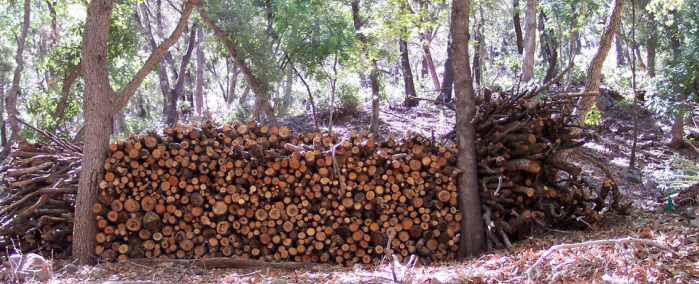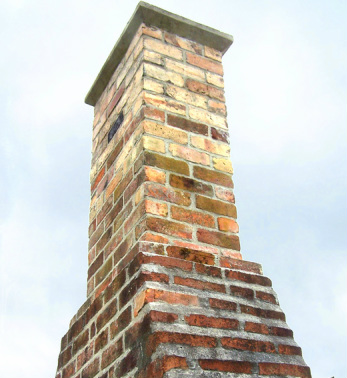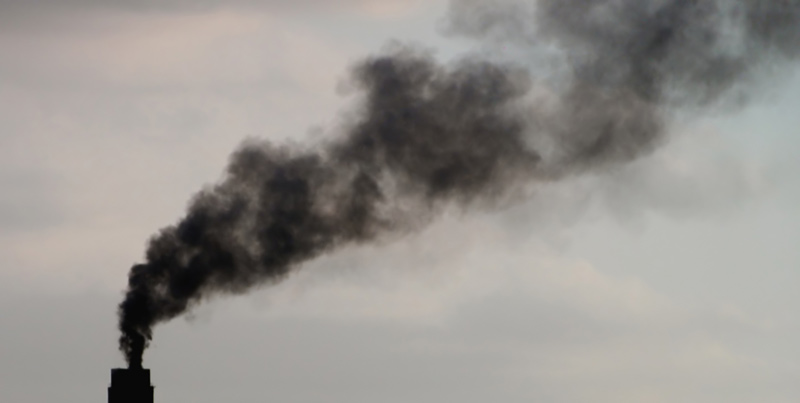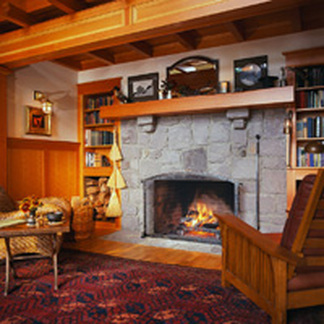|
Burning wood produces environmental impacts. That is why it must be done responsibly. Responsible wood heating should be defended from criticism that it is bad for the environment. In fact it should be promoted on environmental grounds. When we talk about the impact of wood burning on the environment we should consider three distinct forms of impact:
Burn sustainably harvested, properly processed and seasoned fuel in an advanced combustion stove or fireplace that is vented through a chimney that runs straight up through the building. It sounds so simple, but as you can imagine, there are some complex issues and layers of meaning under the surface of the words. Here is a brief explanation.
Properly processed wood is cut to the correct length and split to the correct range of sizes for the appliance. Having wood the right length and range of size makes it easy to build good, clean burning fires. Properly seasoned fuel is split and stacked in an area open to sun and wind for between six and twelve months, depending on how hard the wood is, how large the pieces are and how dry the climate is. You cannot burn without smoke if you are using wet wood. Sustainable harvesting involves selective, uneven age cutting so that an acceptable level of biomass and biodiversity is maintained permanently on the site. Advanced combustion stoves and fireplaces burn wood about 90 per cent cleaner and one-third more efficiently than older conventional appliances. That means a lot less smoke outside and lower forest impacts because less wood is used. And there is a bonus: The same advanced appliance characteristics that result in lower outdoor emissions also result in less chance that smoke will be spilled inside the house. The chimney should run inside the house because if it runs up an outside wall there is a good chance that smoke, odors and cold air will flow backwards into the house, polluting the indoor air. Although there has been a tradition in rural areas of burning garbage in backyard barrels and in wood burning heaters, it is now apparent that when you burn garbage, you're making poison. We should all be working towards environmentally appropriate wood heating. Marlene, a wood burner and one of our visitors, sent us a copy of an article she wrote for her local community newspaper. "Hey Neighbour" is a wonderful contribution to the dialogue on responsible wood heating. Congratulations to Marlene for making a difference in her community. Maybe you could also promote responsible wood heating in your community. You will find several articles here that go into plenty of detail on the environmental impacts of wood heating.
2 Comments
from woodheat.org
A good chimney and system design produces desirable performance characteristics:
This is good wood stove performance: (hint: it's really the chimney that's doing the performing!)
Think of the chimney as the engine that drives the wood heating system. Think of its fuel as heat. Think of the power it puts out as draft. The more fuel (heat) you give this engine (chimney), the more power (draft) it will deliver. So, the hotter the exhaust gases, the more draft is produced. Draft, by the way, is good. It's the suction that keeps the smoke from coming into the room. Insulation in the chimney is important because it helps to keep the exhaust hot until it is expelled outside, and so, increases draft. The chimney works with the stove or fireplace in a kind of feedback loop. Heat in chimney makes draft, which pulls in more combustion air, which makes the fire burn hotter, which delivers more heat to the chimney which makes more draft and so on. An insulated chimney makes more draft with less heat. In winter, a well-designed and properly installed chimney makes some draft and flows some air upwards, even when no fire is burning. When you build a fire in a stove connected to such a chimney, the kindling ignites easily, draft increases rapidly and you have a nice bright, hot fire right away—and no smoking. This is the kind of system you want in your house. "Fireplaces are inherently cleaner than stoves". - Paul Tiegs Almost every fireplace tested in accordance with the Washington State fireplace standard, designed to be "equivalent" to the EPA Phase II stove standard, passed. Some fireplaces, like Rumfords and Rosins, tested two or three times cleaner than the stove standard. (See Rumford Test Results.) So, why do so many people think fireplaces are dirty and inefficient? It all began nearly thirty years ago when the American Lung Association tried to get the EPA to regulate the air-tight European stoves that flooded the US market during the energy crisis of the late 1970's and early 1980's. Americans didn't know how to use the stoves and allowed them to smolder as they bragged to their friends how long they could bank a fire. The Lung Association eventually had to sue the EPA which did not want to get into regulating on a retail basis. It was easier to regulate industry than to dictate what people could do in their own homes. The suit brought against EPA resulted in a very narrowly drawn "smoldering stove" standard. Fireplaces, masonry heaters and other "inherently" clean-burning appliances were exempted. See details) The American stove industry and their association, the Hearth, Patio & Barbecue Association, grew up developing stoves that would pass the EPA emissions standards - and, while they were at it, keep the European stoves out of the US market and buy up or put out of business all the small US stove manufacturers. After thirty years of testing and marketing American stoves, is it any wonder that most of the scientists who do the testing and most of the people who write the articles and research papers work for or are paid by the stove manufactures? Not that they were not objective, especially the scientists running certified independent test labs, but they all had an interest in showing how clean the new and improved American stoves were compared with the bad old stoves and fireplaces. ( For example see Skip Hayden's anti fireplace article.) People who liked and understood fireplaces were not the ones testing fireplaces. Rather it was people who had an interest in showing how bad fireplaces were and how good stoves were who tested fireplaces. How could that be? Does General Motors hire Ford to do marketing? Why didn't the masonry industry take an interest? Suffice it to say fireplaces were "exempt" and the masonry industry, organized like a farmers cooperative, wasn't focused. Who should take responsibility for masonry fireplaces? Masons? Brick and block manufacturers? Flue liner or firebrick manufacturers? Independent dealers who sell the materials? Well none of us took responsibility. We were all out to lunch. We just watched masonry fireplaces denigrated and our markets slip away. Some fireplaces, like Rumfords and Rosins, have tested as clean or cleaner than EPA certified stoves. With more testing, fair standards and more time, we will find even more improvement. What we need are clear objective performance standards and rules that allow fireplaces that meet the same performance standards that the stoves that are allowed meet. We are now working on an ASTM national consensus fireplace emissions standard that EPA will recognize. For much more information about fireplace testing and the politics of fireplace certification, see Rumford's article on Emissions. The Question: What Features Would a Green Fireplace Have?
1) Clean-burning 2) Energy Efficient 3) Integrated Ventilation 4) Durability 5) Thermal Mass 6) Radiant Heat 7) Renewable Fuel Current Green Fireplace Rules There is very little in the Green literature on fireplaces - most of it negative. There seems to be some underlying assumption that fireplaces are dirty and inefficient and, if we must indulge the irrationality of those who love fireplaces, at least we can try to isolate the fireplaces and keep them from interferring with the rest of the modern features in a green house. Some would say the concept of a "green fireplace" is oxymoronic. The emerging National Green Building Standard mostly views fireplaces negatively, requiring new masonry fireplaces to "have gasketed doors, outside combustion air, and a chimney top damper" and awarding up to 7 points for removing fireplaces altogether in renovations.* LEED has some comments about fireplaces under "combustion venting" in the LEED for Homes program. They seem to be mostly concerned about smoking fireplaces and indoor air quality. LEED also recently added a preferred "install no fireplace" option. Googling "green fireplaces" gets a lot of ads about gas and electric fireplaces and some dire predictions about outlawing all wood-burning. In an article about "green stoves" in Hearth Marketing James E. Houck and David R. Broderick interview EPA regulators. Every one seemed to say it was "too early to tell" but went on to advocate the cleanest and most efficient stoves and urged the manufacturers of other wood-burning appliances (but didn't mention fireplaces) to contact EPA about the EPA's "Green Label program". Future of Green Fireplace Rules In a positive note, fireplaces are still permitted according to LEED and National Green Building Standard guidelines, but it may be a struggle to get any "points" for including a fireplace. "Green fireplaces" will have to be clean-burning and efficient. They also may have to be provided with combustion/ventilation air and sealed off with tight-fitting doors and dampers. The fireplace doors, of course, would block most of the radiant heat but the tight-fitting dampers andcombustion/ventilation air sound good if accomplished in conjunction with the LEED recommended whole house perspective on ventilation. With a passing familiarity with the LEED program and our masonry industry efforts to emphasize our strengths, I would add durability and thermal mass. Locating the chimney mass inside the exterior walls of the house and exposing the masonry chimney walls to take advantage of all that thermal mass could be worth points. By knowing how fireplaces heat I would add the advantages of radiant heat and the use of wood as a renewable fuel. All material on Green Fireplaces is by permission of Jim Buckley and the Buckley Rumford Company |
See Our WorkAn All Season Control Cover in action speaks for itself. See how our product solves many types of chimney and fireplace issues. Archives
September 2015
Categories
All
|





 RSS Feed
RSS Feed
